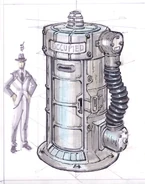Pulowski Preservation shelters are coin-operated, one-person fallout shelters found on street corners throughout the more urban areas of the Capital Wasteland, provided by Pulowski Preservation Services. Advertised as a "sensible" and "affordable" alternative to the Vaults,[1] people would ostensibly use them as a last-minute resort in the event of a nuclear attack. The shelter itself is firmly secured to the ground, and ventilation piping is attached to the rear of the booth. A luminous sign on the front of the shelter indicates whether it is occupied or not.
Pre-War use
Though the shelters can shield against explosive force, they do not seem to shield against radiation. It could be speculated that the installation of so many booths may be seen as a profiteering scheme in the climate of fear before the Great War began, or they may be simply in disrepair when found by the player. The shelters only had an air supply, no food or water, so the occupant's survival was dependent on what they were carrying at the time. Whether any occupant survived through the use of these shelters is unknown, though many are filled with skeletons, suggesting the majority of occupants died trapped inside. The last-minute nature of the booth meant that ill-prepared occupants were likely resigned to die from starvation if they survived the high radiation levels. Considering the blood splatters within several booths containing handguns, it seems that some occupants committed suicide after losing all hope of survival. The only advice offered after entering the booth is: "Wait for radiation to clear. Enjoy your stay." Although somewhat illogical, it seems these shelters were intended to be reusable; considering the tone of advertising the shelters were given, the risk and cost of nuclear devastation pre-War was likely greatly underestimated by the general public.
Post-War use
Though apparently coin operated, the player character can enter simply by pressing on the coin-slot (note no money will be taken when pressing the coin slot). Two centuries later, Pulowski shelters have found new use in protecting citizens of the Wasteland from its dangers; at least one non-player character (Bryan Wilks in "Those!") hides in a Pulowski shelter. Conversely, in Paradise Falls the shelters are used as punishment cells; a Pulowski shelter at the far end of the settlement is used to detain unruly slaves, and is named "The Box". This shelter is unique in that it has also been modified to be lockable, imprisoning the slave (in this case, Rory Maclaren). The key to this shelter is in possession of Forty, typically nearby sitting on a bench or patrolling around the destroyed car wall.
Shelter locations and contents
There are a total of 20 Pulowski preservation shelters located throughout the Capital Wasteland, including "The Box" at Paradise Falls.
- Arlington Cemetery South: contains a mannequin, two shot glasses, sexy sleepwear, and wine. A prostitute may have occupied this shelter.
- Arlington Library: Contains a skeleton with 10mm pistol, two magazines of 10mm rounds, and Guns and Bullets.
- Chevy Chase: Contains one skeleton.
- Chevy Chase Metro: One frag mine in front of hatch, contains three bottles of purified water, a lead pipe and a teddy bear.
- Dupont Circle: Contains two skeletons, a stimpak a Vault-Tec lunchbox, and a .32 pistol. It is possible that a parent and child were in this shelter.
- Falls Church: Contains ammunition box of .32 caliber rounds, ammunition box of 5mm rounds, and two bottles of dirty water.
- Flooded metro: Contains one skeleton, a Chinese Army: Special Ops Training Manual, a pulse grenade and two stimpaks. A Chinese remnant possibly occupied this shelter.
- Georgetown parking lot: Empty.
- Georgetown West: Contains five beers, three cherry bombs, a box of Fancy Lads Snack Cakes, a Nuka-Cola Quantum, some railway spikes, and a box of Sugar Bombs.
- Grayditch: Contains Bryan Wilks during the quest Those!
- Hubris Comics HQ: Contains a conductor, a Dean's Electronics, a hammer, a motorcycle gas tank, and two wrenches. A mechanic possibly occupied this shelter.
- L'Enfant West: Contains a skeleton, a Big Book of Science, a bottle of wine, and a pair of eyeglasses.
- Paradise Falls: Converted into "The Box" for confinement, contains Rory Maclaren.
- Pennsylvania Avenue, east of Metro: Contains a deactivated protectron and an ammunition box of small energy cells
- South of Rivet City: Empty.
- Takoma Park: Contains a recently dead wastelander with random chems and bobby pins, ammunition box with random ammunition.
- The Capitol building, outside the east exit: Contains a briefcase, a Lying, Congressional Style, and four pre-War money. Due to its location and what is inside, it is likely that a Senator or Representative occupied this one.
- Vernon Square: Contains a skeleton, a radiation suit, and Rad-X. A scientist, or possibly a well-supplied citizen, may have occupied this shelter.
- One unreachable shelter glimpsed from the intro movie, the set for which is actually built in-game, has a pair of skeleton legs
There is also a Preservation shelter located in Point Lookout, in the Boardwalk area. It is not meant to be encountered during normal play and can only be reached with console or through strategic jumping. Additionally, it cannot be opened. It is placed there for technical reasons, as it houses the non-player character The Brain which serves as the dialog source for Professor Calvert when discouraging you from deploying the cogwave jammer.
Notes
- While standing in the shelter, Bryan Wilks might ask "What's this funny suction hose for?" The answer is unknown, but logical speculation suggests it's used to dispose of biological waste.
- If the player is under attack by fire ants while next to (or close to) Bryan Wilks while he is in the shelter, you can hear him complaining about the heat and wondering why it is so hot.
- You are not actually protected from radiation or explosions while in a Pulowski preservation shelter. If a car explodes next to you while standing in a shelter, you will take damage and radiation.
- The fan in the back of the shelter only moves if the shelter is occupied.
- Despite the sign telling users to "wait for the radiation to clear", there is no Geiger Counter or any other form of radiation measurement, meaning that residents, if they had survived the other obvious problems, would have to guess at when they could leave.
- The name of the Pulowski Preservation shelter might be loosely based on the real life survival story of Edward Pulaski and his crew of firefighters during the Great Fire of 1910. Pulaski ordered his men to take shelter in an abandoned mine where they narrowly survived after being caught in a backfire.
Gallery
Videos
References
- ↑ Fallout 3 Advert: Pulowski Preservation Services






